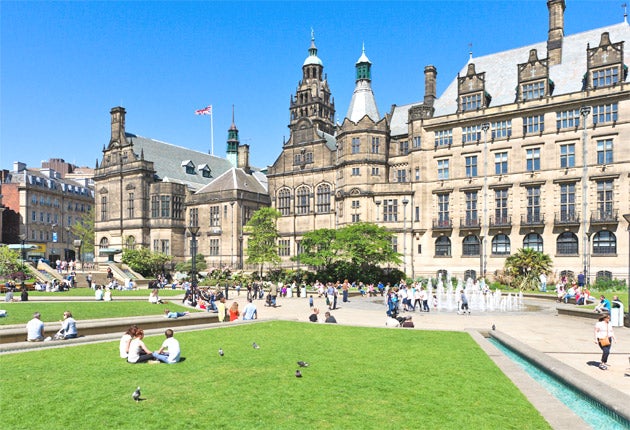Land grab for housing angers National Trust
The changes have provoked opposition from rural groups who warn that the reforms pose a threat to green spaces in cities

Land "twice the size of Leicester" is to be released by the Government in order to tackle the shortage of housing across the UK.
Home-ownership in England is predicted to fall from 72 per cent to just 64 per cent over the next decade, the lowest level since the mid-1980s.
At the same time the average house price is predicted to rise from £214,647 this year to £260,304 in 2016.
In London, the National Housing Federation (NHF) predicts that the majority of people living in the capital will rent by 2021, with the number of owner-occupiers falling from 52 per cent to 44 per cent.
Grant Shapps, the Housing Minister, admitted that not enough houses had been built, but claimed that this could be offset by changes to the planning laws and releasing government-owned land for building.
The Government estimates that the public sector owns 63,750 hectares of previously developed land that might be available for redevelopment, of which 28,810 hectares are suitable to build 1.2 million homes. About 10 per cent of this land is owned by local authorities, and 16 per cent owned by other public bodies.
But the changes have provoked strong opposition from the National Trust and the Campaign to Protect Rural England, who warn that the planned reforms pose a threat to green spaces in cities, towns and villages.
Speaking yesterday, Mr Shapps said that "the only long-term solution" to the housing crisis was "to build more homes". "We are releasing enough government land to build Leicester twice over across the country – it is a massive programme," he said.
"We are reforming the planning system which is massively complex and very, very slow. The Government's aspiration is to meet people's aspirations and lots of people still want to own their own homes. I think it is the Government's responsibility to try and help people meet their aspirations."
But the NHF warned of a bleak outlook due to under-supply of homes. Chief executive, David Orr, said: "With home ownership in decline, rents rising rapidly and social housing waiting lists at a record high, it's time to face up to the fact that we have a totally dysfunctional housing market.
"Home ownership is increasingly the preserve of the wealthy and, in parts of the country like London, the very wealthy. And for the millions locked out of the property market the options are becoming increasingly limited as demand sends rents rising sharply and social homes waiting lists remain at record levels."
A National Trust spokeswoman claimed it was not the laws that were to blame for the low level of house building, but the economy. She said: "We are not against house building. But in our view changing the planning laws risks creating a free for all where development is presumed without any regard to sustainability."
Why Sheffield beats London in price-rise league
London's position at the top of the property price rise ladder has been overthrown by Sheffield, writes Jonathan Brown. The price of prime homes in the South Yorkshire city grew by 10.6 per cent in the first six months of this year, compared to just 2.7 per cent in the capital. Demand for the most sought after homes in regional cities saw Bristol record growth of 9.7 per cent and Cardiff 8.1 per cent, research from property website Primelocation.com found. However a prime property in Sheffield is likely to cost just £319,764 compared to £1,149,129 in London. The top 10 per cent of properties in all areas continued to increase sharply in value – up by £129 per day to an average of £652,862.
What's so great about Sheffield? How about these...
1. Topography
Like Rome, Sheffield is a city of hills – seven in fact. The highest point is at High Stones – 1,798ft (548m).
2. Greenery
With 2.5million trees it is claimed to be the most wooded city in England per head of population. A third of the city is in the Peak District National Park.
3. Cutlery
It founded itself as an industrial powerhouse on steel, coal and of course cutlery. Now Sheffield is building a reputation as a centre for hi-tech industry.
4. Drama
The Crucible Theatre may have staged one of the most nail-biting clashes in snooker history: the 1985 'black ball' final between Dennis Taylor and Steve Davis. Yet when the green baize is packed away, the venue boasts some of the most popular theatre outside the capital. It celebrates its 40th anniversary this year with a season including Othello with local actor Dominic West.
5. Music
The Steel City sound of the 1980s produced ABC, The Human League, Cabaret Voltaire and Heaven 17. In the 1990s there was Pulp, and more recently the Arctic Monkeys.
6. The Derby
Derby clashes between Sheffield United and Wednesday are visceral. The city can lay claim to the world's oldest team – Sheffield FC, founded in 1856. They play in the NPL Division One South.
7. Jessica Ennis
Sheffield is the home of former world champion heptathlete Jessica Ennis.
8. University
The city's two universities give the city one of the biggest (54,000) student populations in Britain.
9. Curry
The Old Vicarage is Sheffield's Michelin-starred restaurant. The city is also famous for the Kashmir Curry Centre.
10. Festivals
175,000 people turn up to Sheffield's Tramlines festival – a three-day celebration of the city's musical heritage.
Subscribe to Independent Premium to bookmark this article
Want to bookmark your favourite articles and stories to read or reference later? Start your Independent Premium subscription today.

Join our commenting forum
Join thought-provoking conversations, follow other Independent readers and see their replies